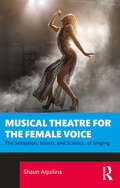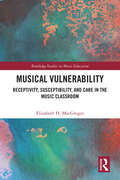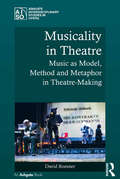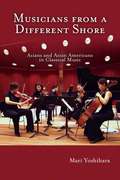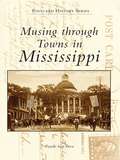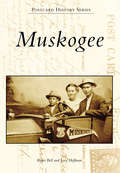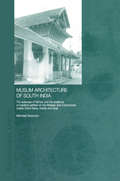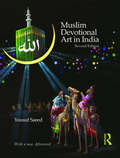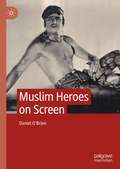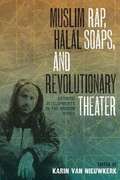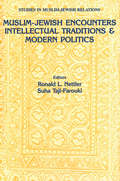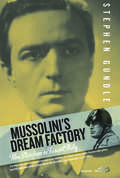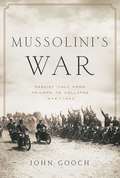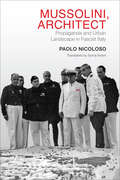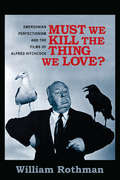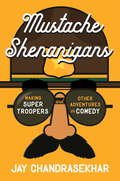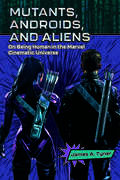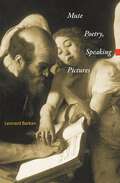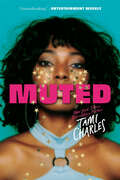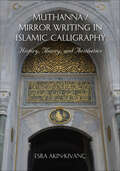- Table View
- List View
Musical Theatre for the Female Voice: The Sensation, Sound, and Science, of Singing
by Shaun AquilinaFemale musical theatre singers produce some of the most exciting and expressive singing an audience can experience. They also face a unique and specific set of issues when approaching their craft, from negotiating the registers of their voice to enable them to belt, to vocal health challenges such as premenstrual voice syndrome. This is the only book that offers a full and detailed guide to tackling those issues and to singing with full expression and technical excellence. Musical Theatre for the Female Voice covers the origin of singing in musicals, from the bel canto style of 300 years ago through to the latest developments in high belting, in shows such as Wicked and Waitress. It offers the reader exercises and methods that have been used to train hundreds of singers at some of the UK’s leading musical theatre training institutions and are underpinned by the latest academic research in journals on singing, psychology, and health. Every element of a singer's toolkit is covered from a female perspective, from breath and posture to character work and vocal health. This is an essential guidebook for female singers in musical theatre productions, either training at university or conservatory level or forging a career as professional triple-threat performers.
Musical Vulnerability: Receptivity, Susceptibility, and Care in the Music Classroom (Routledge Studies in Music Education)
by Elizabeth H. MacGregorSince the early twenty- first century, music education across the world has been shaped by neoliberal discourse extolling the benefits of music upon academic achievement, health and wellbeing, and social development. However, such benefits are far from universal; on the contrary, music- making often reveals our shortcomings and dependencies. This highlights an urgent need for music education to be reframed by an understanding of ‘musical vulnerability’: our inherent and situational openness to being affected by the semantic and somatic properties of music- making.Drawing on existing vulnerability studies, this book evaluates how musicmaking can foster both positive receptivity and negative susceptibility, depending on its delineation of self- identity, social identity, and space, and its embodiment through aural receptivity, mimetic participation, and affective transmission. Through phenomenological, ethnographic research with teachers and pupils, it exposes how values espoused in the music classroom require the personal and interpersonal negotiation of conflicting musical expectations, identities, and abilities. It makes recommendations for music education policymakers, teachers, and researchers in diverse global contexts, suggesting the importance of developing ‘pedagogies of vulnerability’ in order to foster caring classroom music- making praxes that acknowledge music’s capacity both to heal and to harm.
Musicality in Theatre: Music as Model, Method and Metaphor in Theatre-Making (Ashgate Interdisciplinary Studies in Opera)
by David RoesnerAs the complicated relationship between music and theatre has evolved and changed in the modern and postmodern periods, music has continued to be immensely influential in key developments of theatrical practices. In this study of musicality in the theatre, David Roesner offers a revised view of the nature of the relationship. The new perspective results from two shifts in focus: on the one hand, Roesner concentrates in particular on theatre-making - that is the creation processes of theatre - and on the other, he traces a notion of ‘musicality’ in the historical and contemporary discourses as driver of theatrical innovation and aesthetic dispositif, focusing on musical qualities, metaphors and principles derived from a wide range of genres. Roesner looks in particular at the ways in which those who attempted to experiment with, advance or even revolutionize theatre often sought to use and integrate a sense of musicality in training and directing processes and in performances. His study reveals both the continuous changes in the understanding of music as model, method and metaphor for the theatre and how different notions of music had a vital impact on theatrical innovation in the past 150 years. Musicality thus becomes a complementary concept to theatricality, helping to highlight what is germane to an art form as well as to explain its traction in other art forms and areas of life. The theoretical scope of the book is developed from a wide range of case studies, some of which are re-readings of the classics of theatre history (Appia, Meyerhold, Artaud, Beckett), while others introduce or rediscover less-discussed practitioners such as Joe Chaikin, Thomas Bernhard, Elfriede Jelinek, Michael Thalheimer and Karin Beier.
Musicians from a Different Shore: Asians and Asian Americans in Classical Music
by Mari YoshiharaIn the first book to account for the growing prominence of Asians in the world of Western classical music, Mari Yoshihara grapples with the significance of this trend. This is a book about the about the origins of a social and cultural phenomenon, but it is also about the lives and work of individual musicians devoted to their art.
Musik und Internet: Aktuelle Phänomene populärer Kulturen (Musik und Medien)
by Peter Moormann Nicolas RuthStreaming-Plattformen und soziale Medien sind geprägt von mannigfaltigen musikalischen Formen und Inhalten. Mit ihren jeweiligen Oberflächen bzw. Gestaltungs- und Kommunikationsrahmen ermöglichen und prägen sie aktuelle Musikkulturen. Neben lang etablierten Formen, wie dem Popsong, die mehr und mehr von den Plattformlogiken und verkürzten Aufmerksamkeitsspannen strukturell beeinflusst werden, finden sich auch zahlreiche neue Phänomene, die sich aus alltäglichen Netzkulturen herausgebildet haben. Durch die unterschiedlichen Perspektiven und Phänomenaspekte des Bandes wird deutlich, wie relevant das Internet für aktuelle Musikkulturen ist und in welch komplexen Konstellationen dabei Musik gestaltet, distribuiert und rezipiert wird.
Musing Through the Towns of Mississippi
by Wynelle Scott DeeseFrom the 1890s through the 1920s, the postcard was an extraordinarily popular means of communication, and many of the postcards produced during this "golden age" can today be considered works of art. Postcard photographers traveled the length and breadth of the nation snapping photographs of busy street scenes, documenting local landmarks, and assembling crowds of friends and neighbors only too happy to pose for a picture. These images, printed as postcards and sold in general stores across the country, survive as telling reminders of an important era in America's history. This fascinating new history of Mississippi showcases more than two hundred of the best vintage postcards available, all organized into six geographical areas. Several family histories and other historical facts add to the richness of this book.
Muskogee (Postcard History)
by Roger Bell Jerry HoffmanMuskogee was formed in 1872, when the Missouri-Kansas-Texas Railroad (MKT or "the Katy") established a depot on an open plain just a few miles to the south of the confluence of the Arkansas, Grand, and Verdigris Rivers in Indian Territory. A small settlement there soon grew to become the center of political and commercial activity in the territory prior to Oklahoma becoming a state in 1907. Muskogee, once known as the "Queen City of the Southwest," enjoyed major growth after statehood due to oil, cattle, cotton, and the railroads. This book features a diverse collection of Muskogee postcard images that take readers on a trip back in time on a virtual tour of the city.
Muslim Architecture of South India: The Sultanate of Ma'bar and the Traditions of Maritime Settlers on the Malabar and Coromandel Coasts (Tamil Nadu, Kerala and Goa) (Routledge Studies in South Asia)
by Mehrdad ShokoohyThis book reinterprets the Muslim architecture and urban planning of South India, looking beyond the Deccan to the regions of Tamil Nadu and Kerala - the historic coasts of Coromandel and Malabar. For the first time a detailed survey of the Muslim monuments of the historic ports and towns demonstrates a rich and diverse architectural tradition entirely independent from the better known architecture of North India and the Deccan sultanates. The book, extensively illustrated with photographs and architectural drawings, widens the horizons of our understanding of Muslim India and will no doubt pave new paths for future studies in the field.
Muslim Devotional Art in India
by Yousuf SaeedThis book highlights the history of Islamic popular devotional art and visual culture in 20th-century India, weaving the personal narrative of the author’s journey through his understanding of the faith. It begins with an introductory exploration of how the basic and universal image of Mecca and Medina may have been imported into Indian popular print culture and what variants it resulted in here. Besides providing a historical context of the pre-print culture of popular Muslim visuality, the book also explores the impact the 1947 Partition of India may have made on the calendar art in South Asia. A significant portion of the book focuses on the contemporary prints of different localised images found in India and what role these play in the users’ lives, especially in the augmentation of their popular faith and cultural practices. The volume also compares the images published in India with some of those available in Pakistan to reflect different socio-political trajectories. Finally, it discusses why such a vibrant visual culture continues to thrive among South Asian Muslims despite the questions raised by the orthodoxy on its legitimacy in Islam, and why images and popular visual cultures are inevitable for popular piety despite the orthodox Muslims’ increasing dissociation from them. This work is one of the first books on Indian Muslim poster art, with rare images and simple narratives, anecdotes about rituals, ceremonies and cultural traditions running parallel to research findings. This second edition contains a new Afterword that discusses challenges to religious plurality arising on account of changing political landscapes, economic liberalisation, technology and new media, and socio-religious developments. It will appeal to the lay reader as well as the specialist and will be especially useful to researchers and scholars in popular culture, media and cultural studies, visual art and performance studies, and sociology and social anthropology.
Muslim Fashion: Contemporary Style Cultures
by Reina LewisIn the shops of London's Oxford Street, girls wear patterned scarves over their hair as they cluster around makeup counters. Alongside them, hip twenty-somethings style their head-wraps in high black topknots to match their black boot-cut trousers. Participating in the world of popular mainstream fashion--often thought to be the domain of the West--these young Muslim women are part of an emergent cross-faith transnational youth subculture of modest fashion. In treating hijab and other forms of modest clothing as fashion, Reina Lewis counters the overuse of images of veiled women as "evidence" in the prevalent suggestion that Muslims and Islam are incompatible with Western modernity. Muslim Fashion contextualizes modest wardrobe styling within Islamic and global consumer cultures, interviewing key players including designers, bloggers, shoppers, store clerks, and shop owners. Focusing on Britain, North America, and Turkey, Lewis provides insights into the ways young Muslim women use multiple fashion systems to negotiate religion, identity, and ethnicity.
Muslim Heroes on Screen
by Daniel O'BrienIf films drawing on Middle East tropes often highlight white Westerners, figures such as Sinbad and the Thief of Bagdad embody a counter-tradition of protagonists, derived from Islamic folklore and history, who are portrayed as ‘Other’ to Western audiences. In Muslim Heroes on Screen, Daniel O’Brien explores the depiction of these characters in Euro-American cinema from the silent era to the present day. Far from being mere racial masquerade, these screen portrayals are more complex and nuanced than is generally allowed, not least in terms of the shifting concepts and assumptions that inform their Muslim identity. Using films ranging from Douglas Fairbanks’ The Thief of Bagdad, The 7th Voyage of Sinbad, El Cid, Kingdom of Heaven and The Message to The Wind and the Lion, O’Brien considers how the representational strategies of Western filmmakers may transcend such Muslim stereotypes as fanatic antagonists or passive victims. These figures possess a cultural significance which cannot be fully appreciated by Euro-American audiences without reference to their distinction as Muslim heroes and the implications and resonances of an Islamicized protagonist.
Muslim Rap, Halal Soaps, and Revolutionary Theater
by Karin Van NieuwkerkFrom "green" pop and "clean" cinema to halal songs, Islamic soaps, Muslim rap, Islamist fantasy serials, and Suficized music, the performing arts have become popular and potent avenues for Islamic piety movements, politically engaged Islamists, Islamic states, and moderate believers to propagate their religio-ethical beliefs. Muslim Rap, Halal Soaps, and Revolutionary Theater is the first book that explores this vital intersection between artistic production and Islamic discourse in the Muslim world. The contributors to this volume investigate the historical and structural conditions that impede or facilitate the emergence of a "post-Islamist" cultural sphere. They discuss the development of religious sensibilities among audiences, which increasingly include the well-to-do and the educated young, as well as the emergence of a local and global religious market. At the heart of these essays is an examination of the intersection between cultural politics, performing art, and religion, addressing such questions as where, how, and why pop culture and performing arts have been turned into a religious mission, and whether it is possible to develop a new Islamic aesthetic that is balanced with religious sensibilities. As we read about young Muslims and their quest for a "cool Islam" in music, their struggle to quell their stigmatized status, or the collision of morals and the marketplace in the arts, a vivid, varied new perspective on Muslim culture emerges.
Muslim Women Are Everything: Stereotype-Shattering Stories of Courage, Inspiration, and Adventure
by Seema YasminWinner of the 2021 International Book Awards Winner of American Book Fest's 2020 Best Book Awards in Women’s IssuesA full-color illustrated collection of riveting, inspiring, and stereotype-shattering stories that reveal the beauty, diversity, and strength of Muslim women both past and present.Tired of seeing Muslim women portrayed as weak, sheltered, and limited, journalist Seema Yasmin reframes how the world sees them, to reveal everything they CAN do and the incredible, stereotype-shattering ways they are doing it.Featuring 40 full-color illustrations by illustrator Fahmida Azim throughout, Muslim Women Are Everything is a celebration of the ways in which past and present Muslim women from around the world are singing, dancing, reading, writing, laughing, experimenting, driving, and rocking their way into the history books.Forget subservient, oppressed damsels—say hello to women who are breaking down barriers using their art, their voices, and their activism, including:Tesnim Sayar from Denmark, a Muslim goth-punk who wears a red tartan mohawk on top of her hijabAmerican superstar singer SZANura Afia, CoverGirl’s first hijabi ambassadorIlhan Omar and Rashida Tlaib, America’s first Muslim congresswomenIlyana Insyirah, a hijaab-wearing scuba-diving midwife from AustraliaShowcasing women who defy categorization, Muslim Women Are Everything proves that to be Muslim and a woman is to be many things: strong, vulnerable, trans, disabled, funny, entrepreneurial, burqa or bikini clad, and so much more.
Muslim-Jewish Encounters (Studies In Muslim-jewish Relations Ser. #Vol. 4.)
by NettlerFirst Published in 1998. Routledge is an imprint of Taylor & Francis, an informa company.
Mussolini's Dream Factory
by Stephen GundleThe intersection between film stardom and politics is an understudied phenomenon of Fascist Italy, despite the fact that the Mussolini regime deemed stardom important enough to warrant sustained attention and interference. Focused on the period from the start of sound cinema to the final end of Fascism in 1945, this book examines the development of an Italian star system and evaluates its place in film production and distribution. The performances and careers of several major stars, including Isa Miranda, Vittorio De Sica, Amedeo Nazzari, and Alida Valli, are closely analyzed in terms of their relationships to the political sphere and broader commercial culture, with consideration of their fates in the aftermath of Fascism. A final chapter explores the place of the stars in popular memory and representations of the Fascist film world in postwar cinema.
Mussolini's Navy: A Reference Guide to the Regia Marina, 1930–1945
by Maurizio Brescia&“A simply magnificent book describing the Italian Navy of the Second World War, profiling all classes of vessels, from battleships . . . [to] submarines.&” —Pegasus Archive This book is a complete guide to the Regia Marina, the navy with which Italy fought the Second World War. Starting with the historical background, it describes how the navy developed, how it was organized, the facilities that supported it, and the operations it conducted both before and after the armistice in 1943. It also details all its ships, with full technical particulars, plans and photos. Furthermore, there are chapters on special topics like camouflage; uniforms, decorations and insignia; and a &“who&’s who&” of important naval personalities; and the reference value of the book is enhanced by a comprehensive bibliography and guide to sources. The illustration is a noteworthy feature of the book as the author&’s collection of naval photographs is one of the best in Italy. He is also a fine draughtsman, and his ship plans and color illustrations are both detailed and accurate, adding a particular appeal for modelmakers. Of all the main combatant navies of this era, the Italian is probably the most poorly represented in English publications, so this comprehensive handbook will be especially welcomed by the naval community.&“An overview of the wartime Italian Navy, including its bases and organization, ships and aircraft . . . an enjoyable book.&” —Warships International Fleet Review&“A major achievement and a milestone in the renaissance of Italian Naval history . . . [the] book is a gem and is thoroughly recommended.&” —The Navy Vol 75
Mussolini's War: Fascist Italy from Triumph to Collapse: 1935-1943
by John GoochA remarkable new history evoking the centrality of Italy to World War II, outlining the brief rise and triumph of the Fascists, followed by the disastrous fall of the Italian military campaign.While staying closely aligned with Hitler, Mussolini remained carefully neutral until the summer of 1940. At that moment, with the wholly unexpected and sudden collapse of the French and British armies, Mussolini declared war on the Allies in the hope of making territorial gains in southern France and Africa. This decision proved a horrifying miscalculation, dooming Italy to its own prolonged and unwinnable war, immense casualties, and an Allied invasion in 1943 that ushered in a terrible new era for the country. John Gooch's new history is the definitive account of Italy's war experience. Beginning with the invasion of Abyssinia and ending with Mussolini's arrest, Gooch brilliantly portrays the nightmare of a country with too small an industrial sector, too incompetent a leadership and too many fronts on which to fight. Everywhere—whether in the USSR, the Western Desert, or the Balkans—Italian troops found themselves against either better-equipped or more motivated enemies. The result was a war entirely at odds with the dreams of pre-war Italian planners—a series of desperate improvisations against an allied force who could draw on global resources, and against whom Italy proved helpless.
Mussolini, Architect: Propaganda and Urban Landscape in Fascist Italy (Toronto Italian Studies)
by Paolo NicolosoDuring the fascist years in Italy, architecture and politics enjoyed a close alliance. Benito Mussolini used architecture to educate the masses, exploiting its symbolic prowess as a powerful tool for achieving political consensus. Mussolini, Architect examines Mussolini in Italy from 1922 to 1943 and expands the traditional interpretations of fascism, advancing the claim that Mussolini devised and implemented architecture as a tool capable of determining public behaviour and influencing opinion. Paolo Nicoloso challenges the assertion that Mussolini was of minimal influence on Italian architecture and argues that in fact the fascist leader played a strong role in encouraging civic architectural development in order to reflect the totalitarian values of the period. Drawing on archival documents, Nicoloso lists the architects who gave Mussolini ideas and describes the times when the dictator himself sometimes picked up a pencil and suggested changes. Examining the political, social, and architectural history of the fascist period, Mussolini, Architect gives careful attention to the final years of fascist rule in order to demonstrate the extent to which Mussolini was intent on shaping Italy and its citizens through architectural projects.
Must We Kill the Thing We Love?: Emersonian Perfectionism and the Films of Alfred Hitchcock (Film and Culture Series)
by William RothmanWilliam Rothman argues that the driving force of Hitchcock's work was his struggle to reconcile the dark vision of his favorite Oscar Wilde quote, "Each man kills the thing he loves," with the quintessentially American philosophy, articulated in Emerson's writings, that gave classical Hollywood movies of the New Deal era their extraordinary combination of popularity and artistic seriousness. A Hitchcock thriller could be a comedy of remarriage or a melodrama of an unknown woman, both Emersonian genres, except for the murderous villain and godlike author, Hitchcock, who pulls the villain's strings—and ours. Because Hitchcock believed that the camera has a murderous aspect, the question "What if anything justifies killing?," which every Hitchcock film engages, was for him a disturbing question about his own art. Tracing the trajectory of Hitchcock's career, Rothman discerns a progression in the films' meditations on murder and artistic creation. This progression culminates in Marnie (1964), Hitchcock's most controversial film, in which Hitchcock overcame his ambivalence and fully embraced the Emersonian worldview he had always also resisted.Reading key Emerson passages with the degree of attention he accords to Hitchcock sequences, Rothman discovers surprising affinities between Hitchcock's way of thinking cinematically and the philosophical way of thinking Emerson's essays exemplify. He finds that the terms in which Emerson thought about reality, about our "flux of moods," about what it is within us that never changes, about freedom, about America, about reading, about writing, and about thinking are remarkably pertinent to our experience of films and to thinking and writing about them. He also reflects on the implications of this discovery, not only for Hitchcock scholarship but also for film criticism in general.
Mustache Shenanigans: Making Super Troopers and Other Adventures in Comedy
by Jay ChandrasekharDirector, writer, and actor Jay Chandrasekhar tells the hilarious history of his comedy group, Broken Lizard, and the making of the cult film Super Troopers, as well as the currently filming Super Troopers 2.Jay Chandrasekhar has spent the past two decades writing, directing, and acting in film and TV. With his comedy group, Broken Lizard, he has produced and directed beloved movies such as Super Troopers, Beerfest, and Club Dread. Now, with the upcoming release of the long-awaited Super Troopers 2, Jay is ready to tell the ridiculous, madcap, dead-honest story of how he built his career, how he formed Broken Lizard, and, ultimately, how he made Super Troopers. Jay grew up Indian American in the lily-white suburbs of Chicago, and he had an outsider’s perspective from the beginning. Instead of taking the traditional acting path, he formed his own troupe, wrote his own scripts, and made movies his own way. And he had an incredibly good time doing so as readers will learn in this hilarious story about making it in Hollywood and directing, cowriting, and costarring in one of the best-loved and most-watched comedies of all time. Part humorous memoir, part film study, this book will inform, entertain, and tell readers what drinking multiple bottles of maple syrup is really like.
Mutants, Androids, and Aliens: On Being Human in the Marvel Cinematic Universe
by James A. TynerIn both literature and film, mutants, androids, and aliens have long functioned as humanity’s Other—nonhuman bodies serving as surrogates to explore humanity’s prejudice, bigotry, and hatred. Scholars working in fields of feminism, ethnic studies, queer studies, and disability studies, among others, have deconstructed representations of the Othered body and the ways these fictional depictions provide insight into the contested terrains of identity, subjectivity, and personhood. In science fiction more broadly and the superhero genre in particular, the fictional Other—often a superhero or a villain—is juxtaposed against the normal human, and such Others have long been the subject of academic investigation. Author James A. Tyner shifts this scholarly focus to consider the ordinary humans who ally with or oppose Othered superheroes. Law enforcement officers, military officials, politicians, and the countless, nameless civilians are all examples of humans who try to make sense of a rapidly changing more-than-human and other-than-human universe. The resulting volume, Mutants, Androids, and Aliens: On Being Human in the Marvel Cinematic Universe, provides a critical posthumanist reading of being human in the Marvel Cinematic Universe (MCU). Centering the MCU’s secondary human characters, including Matthew Ellis, Ellen Nadeer, Rosalind Price, as well as Jimmy Woo, Sadie Deever, Holden Radcliffe, and others, Tyner considers how these characters attempt to monitor, incarcerate, or exterminate those beings considered "unnatural" and thus threatening. Placing into conversation posthumanism, environmental ethics, and myriad philosophical and biological ontologies of life and death, Tyner maintains that the superhero genre reflects the current complexities of meaningful life—and of what happens in society when "the human" is no longer the unquestioned normative standard.
Mute Poetry, Speaking Pictures (Essays in the Arts)
by Leonard BarkanThe skirmish between painting and poetry—from Plato and Praxiteles to Rembrandt and ShakespeareWhy do painters sometimes wish they were poets—and why do poets sometimes wish they were painters? What happens when Rembrandt spells out Hebrew in the sky or Poussin spells out Latin on a tombstone? What happens when Virgil, Ovid, or Shakespeare suspend their plots to describe a fictitious painting? In Mute Poetry, Speaking Pictures, Leonard Barkan explores such questions as he examines the deliciously ambiguous history of the relationship between words and pictures, focusing on the period from antiquity to the Renaissance but offering insights that also have much to say about modern art and literature.The idea that a poem is like a picture has been a commonplace since at least ancient Greece, and writers and artists have frequently discussed poetry by discussing painting, and vice versa, but their efforts raise more questions than they answer. From Plutarch ("painting is mute poetry, poetry a speaking picture") to Horace ("as a picture, so a poem"), apparent clarity quickly leads to confusion about, for example, what qualities of pictures are being urged upon poets or how pictorial properties can be converted into poetical ones.The history of comparing and contrasting painting and poetry turns out to be partly a story of attempts to promote one medium at the expense of the other. At the same time, analogies between word and image have enabled writers and painters to think about and practice their craft. Ultimately, Barkan argues, this dialogue is an expression of desire: the painter longs for the rich signification of language while the poet yearns for the direct sensuousness of painting.
Muted
by Tami CharlesA ripped-from-the-headlines novel of ambition, music, and innocence lost, perfect for fans of Elizabeth Acevedo and Jason Reynolds!Be bold. Get seen. Be Heard.For seventeen-year-old Denver, music is everything. Writing, performing, and her ultimate goal: escaping her very small, very white hometown.So Denver is more than ready on the day she and her best friends Dali and Shak sing their way into the orbit of the biggest R&B star in the world, Sean "Mercury" Ellis. Merc gives them everything: parties, perks, wild nights -- plus hours and hours in the recording studio. Even the painful sacrifices and the lies the girls have to tell are all worth it.Until they're not.Denver begins to realize that she's trapped in Merc's world, struggling to hold on to her own voice. As the dream turns into a nightmare, she must make a choice: lose her big break, or get broken.Inspired by true events, Muted is a fearless exploration of the dark side of the music industry, the business of exploitation, how a girl's dreams can be used against her -- and what it takes to fight back.
Muthanna/Mirror Writing in Islamic Calligraphy: History, Theory, and Aesthetics
by Esra Akin-KivançMuthanna, also known as mirror writing, is a compelling style of Islamic calligraphy composed of a source text and its mirror image placed symmetrically on a horizontal or vertical axis. This style elaborates on various scripts such as Kufic, naskh, and muhaqqaq through compositional arrangements, including doubling, superimposing, and stacking. Muthanna is found in diverse media, ranging from architecture, textiles, and tiles to paper, metalwork, and woodwork. Yet despite its centuries-old history and popularity in countries from Iran to Spain, scholarship on the form has remained limited and flawed. Muthanna / Mirror Writing in Islamic Calligraphy provides a comprehensive study of the text and its forms, beginning with an explanation of the visual principles and techniques used in its creation. Author Esra Akin-Kivanc explores muthanna's relationship to similar forms of writing in Judaic and Christian contexts, as well as the specifically Islamic contexts within which symmetrically mirrored compositions reached full fruition, were assigned new meanings, and transformed into more complex visual forms. Throughout, Akin-Kivanc imaginatively plays on the implicit relationship between subject and object in muthanna by examining the point of view of the artist, the viewer, and the work of art. In doing so, this study elaborates on the vital links between outward form and inner meaning in Islamic calligraphy.
Muy Bueno: 100+ Delicious Mexican Recipes for Celebrating the Year
by Yvette Marquez-SharpnackYou&’ll discover how to show your love on Valentine&’s Day with Heart-Shaped Berry Empanadas, celebrate Mother&’s Day with Guava Mimosas, whip up Chile Braised Pork Ribs for Día de los Muertos; make a big batch of Red Chile and Chicken Tamales for the December holidays, and much more. Included along with the over 100 delicious, seasonal recipes are step-by-step instructions for making holiday-themed crafts that are fun for children and grown-ups alike. With its gorgeous food photography, detailed recipe directions, and wealth of tips to guide you in the kitchen, Muy Bueno: FIESTAS turns every day into a celebration. 100+ RECIPES: Includes a broad selection of classic and contemporary Mexican recipes, including substantial soups and salads, hearty mains, cocktails, and decadent desserts. RECIPES FOR EVERY OCCASION: Whether you&’re preparing for a 4th of July BBQ or Mexican Independence Day, cooking for a crowd on Easter, or honoring loved ones on Día de los Muertos, Muy Bueno: FIESTAS features easy-to-follow recipes for all occasions, big and small. DIY CRAFTS: Instructions for decorative crafts to help set the stage for a memorable occasion!
